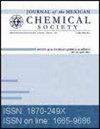Synthesis, in vitro Antitrichomonal Activity, and Docking Study of N-[(4-substituted phenyl)-1,3-thiazol-2-yl]-4-substituted Benzenesulfonamides
IF 0.8
4区 化学
Q3 CHEMISTRY, MULTIDISCIPLINARY
引用次数: 0
Abstract
Infection by Trichomonas vaginalis has a high incidence/prevalence worldwide. It has been associated with a predisposition to cervical neoplasia or prostate cancer and an increased risk of acquisition of human papillomavirus (HPV) and human immunodeficiency virus (HIV). Besides, resistance to the drugs used for trichomoniasis treatment has increased in the last 30 years. Herein, thirteen phenylthiazolylbenzene sulfonamides were synthesized and evaluated for their in vitro activity against Trichomonas vaginalis. Among them, four derivatives showed higher anti-trichomonal activity than metronidazole (IC50 = 0.93 µM), while their cytotoxicity levels were not significant. These compounds were subject to molecular docking studies using Trichomonas vaginalis ferredoxin as target. The results revealed that the orientation of the nitro group of the active derivatives is toward [2Fe-2S], the cluster responsible for high reactive oxygen species generation. Finally, it was evident that the presence of a nitro group in the structure of the synthesized phenylthiazolylbenzene sulfonamides is essential for their trichomonicidal activity. Resumen. A nivel mundial la infección por Trichomonas vaginalis tiene una alta incidencia/prevalencia y se ha asociado con una predisposición a padecer neoplasia cervical o cáncer de próstata, así como a generar un mayor riesgo de adquirir el virus del papiloma humano (VPH) y el virus de la inmunodeficiencia humana (VIH). Además, en los últimos 30 años, la resistencia a los fármacos utilizados para el tratamiento de la tricomoniasis ha aumentado. En el presente trabajo, trece sulfonamidas de feniltiazolilbenceno fueron sintetizadas y evaluadas in vitro contra Trichomonas vaginalis. Cuatro de ellas exhibieron una actividad anti-tricomonas mayor que el metronidazol (CI50 = 0.93 µM), a la vez que citotoxicidad no significativa. Por tal motivo, estos compuestos fueron sometidos a estudios de acoplamiento molecular utilizando como diana a la ferredoxina de T. vaginalis. Los resultados revelaron que la orientación del grupo nitro de los derivados activos está dirigida hacia el grupo [2Fe-2S], responsable de la generación de especies de oxígeno altamente reactivas. Finalmente, se evidenció que la presencia de al menos un grupo nitro en la estructura de las sulfonamidas de feniltiazolilbenceno sintetizadas es esencial para su actividad tricomonicida.N-[(4-取代苯基)-1,3-噻唑-2-基]-4-取代苯磺酰胺的合成、体外抗滴虫活性和 Docking 研究
阴道毛滴虫感染在全世界的发病率/流行率都很高。滴虫性阴道炎与宫颈肿瘤或前列腺癌的易感性有关,也增加了感染人类乳头瘤病毒(HPV)和人类免疫缺陷病毒(HIV)的风险。此外,在过去 30 年中,治疗滴虫病的药物的抗药性也在增加。本文合成了十三种苯噻唑苯磺酰胺类药物,并评估了它们对阴道毛滴虫的体外活性。其中,四种衍生物的抗滴虫活性高于甲硝唑(IC50 = 0.93 µM),而它们的细胞毒性水平并不显著。这些化合物以阴道毛滴虫铁氧还蛋白为靶标进行了分子对接研究。结果显示,活性衍生物的硝基朝向[2Fe-2S],而[2Fe-2S]是产生高活性氧的簇。最后,合成的苯噻唑苯磺酰胺类化合物的结构中显然存在硝基,这对其杀毛滴虫活性至关重要。 总结。阴道毛滴虫感染在全世界的发病率/流行率都很高,并且与宫颈肿瘤或前列腺癌的易感性以及感染人类乳头瘤病毒(HPV)和人类免疫缺陷病毒(HIV)的风险增加有关。此外,在过去 30 年中,治疗滴虫病的药物的抗药性也在增加。本研究合成了 13 种苯噻唑苯磺酰胺类药物,并对其进行了抗阴道毛滴虫的体外评估。其中四种化合物的抗滴虫活性高于甲硝唑(CI50 = 0.93 µM),且细胞毒性不明显。因此,研究人员以阴道毛滴虫的铁氧还蛋白为靶标,对这些化合物进行了分子对接研究。研究结果表明,活性衍生物的硝基朝向[2Fe-2S]基团,负责产生高活性氧物种。最后,合成的苯噻唑苯磺酰胺类化合物的结构中至少存在一个硝基,这对其杀毛滴虫活性至关重要。
本文章由计算机程序翻译,如有差异,请以英文原文为准。
求助全文
约1分钟内获得全文
求助全文
来源期刊
CiteScore
2.00
自引率
0.00%
发文量
0
审稿时长
6-12 weeks
期刊介绍:
The Journal of the Mexican Chemical Society (J. Mex. Chem. Soc.) is a scientific, blind, peer reviewed, and open access, free of charge publication that covers all areas of chemistry and its sub-disciplines (i.e. medicinal chemistry, natural products, electrochemistry, material science, computational chemistry, organic chemistry, bionirganic chemistry, etc). It is devoted to facilitating the worldwide advancement of our understanding of chemistry. It will primarily publish original contributions of research in all branches of the theory and practice of chemistry in its broadest context as well as critical reviews in active areas of chemical research where the author has published significant contribution. The J. Mex. Chem. Soc. is a quarterly publication which language of submission and publication is English. To be suitable for publication in J. Mex. Chem. Soc., manuscripts must describe novel aspects of chemistry, high quality of results and discussion an excellent bibliographic support, and contribute to the development of the field. Routine or incremental work are not suitable for publication in J. Mex. Chem. Soc. Authors are encouraged to send contributions in electronic form. Our online submission system guides you stepwise through the process of entering your article details and uploading your files.

 求助内容:
求助内容: 应助结果提醒方式:
应助结果提醒方式:


